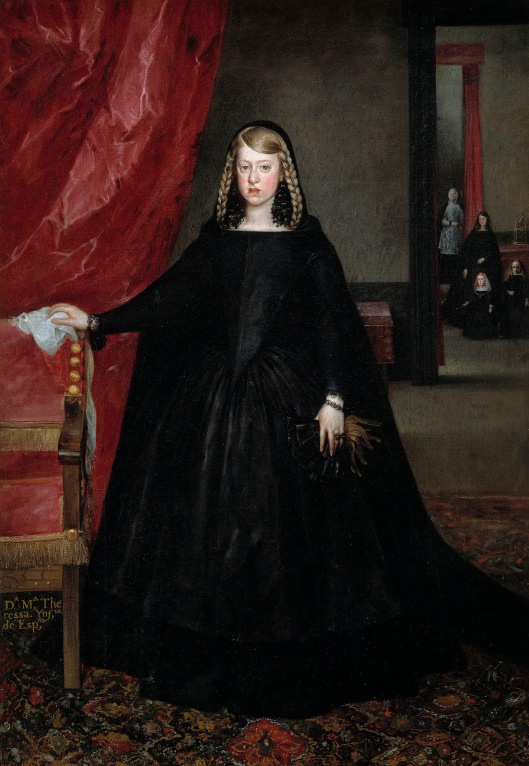Tags
Archduchess Maria Antonia of Austria, Holy Roman Emperor Leopold I, Holy Roman Empire, House of Bourbon, House of Habsburg, King Louis XIV of France, Margaret Theresa of Spain, Philip IV of Spain, Philip V of Spain, War of the Spanish Succession
Holy Roman Empress and German Queen
The Infanta Margaret-Theresa formally entered Vienna On December 5, 1666. The official marriage ceremony was celebrated seven days later. The Viennese celebrations of the imperial marriage were among the most splendid of all the Baroque era, and lasted almost two years.
The Emperor Leopold ordered the construction of an open-air theatre near the present Burggarten, with a capacity of 5,000 people. For Margaret-Theresa’s birthday in July 1668, the theatre hosted the premiere of the opera Il pomo d’oro (The Golden Apple). Composed by Antonio Cesti, the opera was called the “staging of the century” by contemporaries due to its magnificence and expense. The year before, the Emperor gave an equestrian ballet where he personally mounted on his horse, Speranza; due to technical adaptations, the ballet gave spectators the impression that horses and carriages were hovering in the air.

Margaret-Theresa, Holy Roman Empress
Despite the age difference, Leopold was 26 and Margaret-Theresa was 15 at the time of the marriage, according to contemporaries they had a happy marriage. The Empress always called her husband “Uncle” and he called her “Gretl”. The couple had many common interests, especially in art and music.
During her six years of marriage, Margaret gave birth to four children, of whom only one survived infancy:
* Ferdinand Wenceslaus Joseph Michael Eleazar (1667-1668), Archduke of Austria.
* Maria Antonia Josepha Benedicta Rosalia Petronella (1669-1692), Archduchess of Austria, who inherited her mother’s claims to the Spanish throne, married Maximilian II Emanuel, Elector of Bavaria and was the mother of Joseph-Ferdinand of Bavaria.
* John Leopold (born and died 20 February 1670), Archduke of Austria.
* Maria Anna Josepha Antonia Apollonia Scholastica (February 9, 1672 – 23 February 1672), Archduchess of Austria.
The Empress was intensely anti-Semitic, and inspired her husband to expel the Jews from Vienna, because she believed that they were to blame for her children’s deaths. During the Corpus Christi celebration of 1670, the Emperor ordered the destruction of the Vienna synagogue and a church was built on the site on his orders.

Leopold I, Holy Roman Emperor
Even after her marriage, Margaret-Theresa kept her Spanish customs and ways. She did not speak German, and the arrogance of her native retinue led to a strong anti-Spanish sentiment among the imperial court. The courtiers openly expressed the hope that the weak Empress would soon die and thus give Leopold I the opportunity of a second marriage.
Death
During her last pregnancy Margaret-Theresa fell ill with bronchitis; this, along with her already weakened health due to four living childbirths and at least two miscarriages during her marriage, caused her early death on March 12, 1673, at the age of 21.
She was buried in the Imperial Crypt, in Vienna. Only four months later, the widower Emperor – despite his grief for the death of his “only Margareta” (as he remembered her) – entered into a second marriage with Archduchess Claudia-Felicitas of Austria, member of the Tyrol branch of the House of Habsburg.
After Margaret-Theresa’s death, her rights over the Spanish throne were inherited by her only surviving daughter Maria-Antonia, who in turn passed them to her only surviving son Prince Joseph-Ferdinand of Bavaria when she died in 1692.
After Joseph-Ferdinand’s early death in 1699, the rights of inheritance were disputed by both Emperor Leopold I and King Louis XIV of France, son-in-law of King Felipe IV, and grandson of King Felipe III. The outcome of the War of the Spanish Succession was the creation of the Spanish branch of the House of Bourbon in the person of King Felipe V, Margaret’s great-nephew.
Daughter

Archduchess Maria-Antonia of Austria
Archduchess Maria-Antonia of Austria (January 18, 1669 – December 24, 1692) the eldest daughter and only surviving child of Holy Roman Emperor Leopold I and his wife Infanta Margaret-Theresa of Spain. She was the heir to the Spanish throne after her maternal uncle Carlos II of Spain from 1673 until her death. Archduchess Maria-Antonia of Austria was an Electress of Bavaria by marriage to Maximilian II Emanuel, Elector of Bavaria.
On July 11, 2020, I featured Maria-Antonia of Austria’s husband, Maximilian II Emanuel, Elector of Bavaria, here on the blog.
July 11, 1662: Birth of Maximilian II Emanuel, Elector of Bavaria

I have a 1668 London Gazette that proves she was actually born in January 1668.
Can post a photo copy of it?